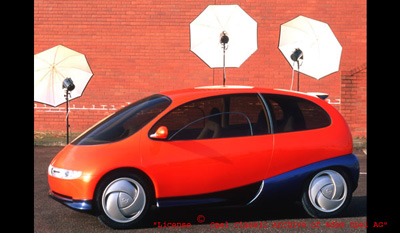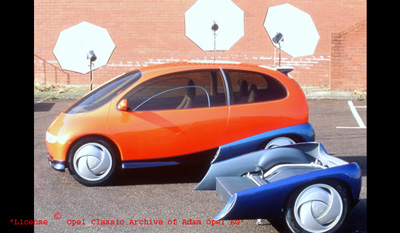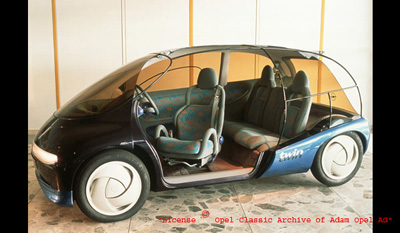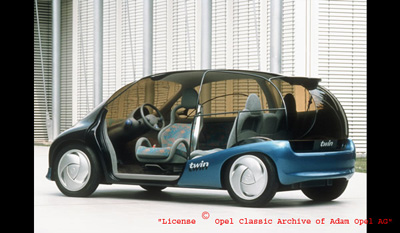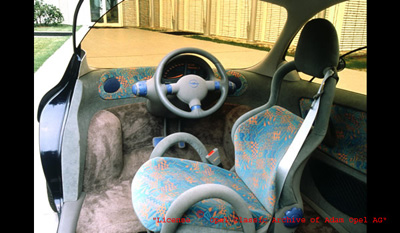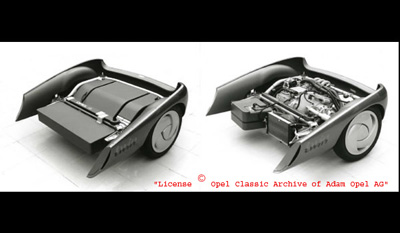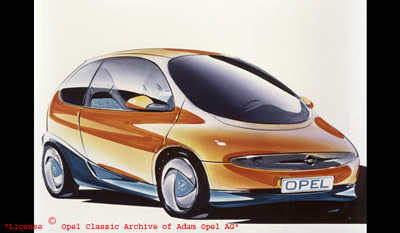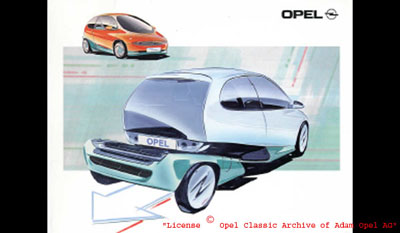|
|
OPEL TWIN Gasoline or Electric Propulsion Design Study 1992
At the 1992 Geneva Motor Show, Opel has introduced the TWIN, a brand new concept for a compact vehicle of the future. This Corsa-sized model is notable for a variety of technical innovations. A special feature of the Opel TWIN includes interchangeable drive module incorporating engine/motors, transmission and rear axle. The whole drive-train is combined in a compact interchangeable module. There are two different modules that can be installed at the rear of the car in just a few minutes, enabling the driver to select the propulsion method which is most economical and environmentally-compatible for his particular journey. The selection include a 34 hp/25 kW three cylinder gasoline engine with transmission and fuel tank or an electric module with two 10 kW/14 hp motors and storage batteries.
This innovative modular technology makes a completely new automobile concept possible with a “passenger compartment” providing and original seating arrangement; the driver seat occupies an individual and central position while a bench seat is available for three rear passengers. The luggage space behind this bench has the same volume as that of a conventional car of this size.
The original Opel TWIN is a full-scale model for demonstration of the project. Opel intended to test the public’s reaction to this new vehicle concept. Opel plan was to examine any noteworthy ideas put forward by members of the public and thus develop a road-going prototype of this design study. As of today, only the scale-model is reported to exist.
The TWIN is an example of how Opel engineers are working on reducing fuel consumption and carbon dioxide emissions. The gasoline engine module is designed for a consumption of 3,5 litre per 100 km. It combines an 800 cc. three cylinder engine with four valves per cylinder fitted with a six-speed automatic transmission. The low consumption objective was to be achieved by using lightweight materials as well as optimized aerodynamic efficiency and low rolling resistance radial tyres.
The gasoline engine is installed on its side in the drive module to keep height to a minimum.
An automatic start/stop system helps to cut fuel consumption in urban traffic.
With this drive module, acceleration from 0 to 100 kph (62 mph) is claimed in 20 seconds and the maximum speed is announced for 140 kph (87 mph); The TWIN can travel an average distance of 571 kilometres (354 miles).
When designing the interchangeable electric module for the TWIN, Opel engineers were able to draw on years of experience in developing electrically-driven prototypes such as Impuls I and Impuls II that were essentially production models converted to electric propulsion. In the TWIN they aim to use wheel-hub motors of particularly compact design. This dispenses with additional drive elements such as the differential and half-shafts: each of the two motors drives its wheel directly at a constant ratio of 7:1. An electronic power system, also comprising two components, controls the electric driveline.
Each three-phase asynchronous motor develops 10 kW/14 hp. Maximum torque is 24 Newton-meters. The electric TWIN accelerates from 0 to 50 kph in seven seconds and reaches a maximum speed of about 120 kph. Energy consumption at a constant speed of 90 kph is calculated in the region of 11,5 kWh per 100 kilometres.
The 250 kilogram battery is the heart of the electric module. Opel engineers plan to use a new kind of “cold” high-energy battery which was under development and was expected to be available for series production by the mid-1990s. This battery operates on a lithium-carbon base with an energy density around 200 watt hours per litre. The energy store planned for use in the electric module of TWIN research vehicle measures 145 litres in volume and weighs 290 kilograms. Its energy content is equal to 29 kilowatt hours, which makes this electric car’s average range about 250 kilometres.
When designing the interior of the TWIN, Opel attached the greatest importance to ride comfort and operating convenience. To make it easy for the driver to get in and out of the central seat position, the single front seat is moved forwards and to the side by electric motors. It also pivots so that the driver can turn to face the rear seat passengers when the car is stationary. Passengers are carried in comfort on a well upholstered rear bench seat, the outside sections of which are fitted with fold-down footrests.
The scale model demonstration TWIN design study was unfortunately not followed officially by a running prototype. This make it so that most specifications and performances figures are calculated design values.
|
|








